Nearly every professional contractor uses an air compressor. Of course, it’s not just a construction tool. Automotive, woodworking, aviation, marine, and many others use a compressor to power air tools. When we got our team together to decide on the best air compressor, we sparked a fierce debate concerning brands, styles, prices, and much more.
Now that the physical and relational bruises have healed, we’re ready to share our expert opinions across a wide range of categories.
Best Air Compressor Overall – Our Top Pick
Metabo HPT 8-gallon Portable Air Compressor EC1315SM
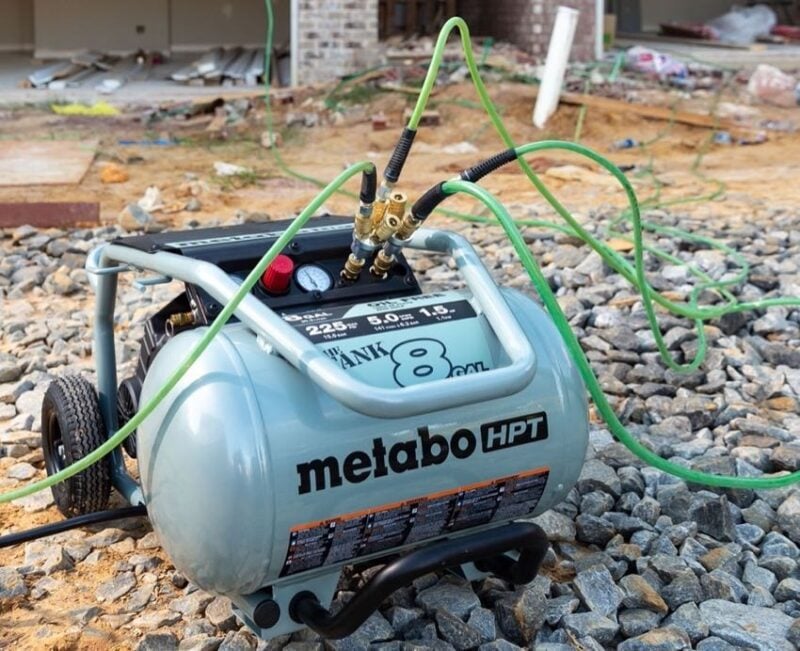
Coming off of the success of the Metabo HPT pancake air compressor (also called “The Tank”), the 8-gallon EC1315SM delivers more CFM and capacity. Delivering up to 225 PSI and 5 CFM (at 90 PSI), you can run 3 framing nailers or 4 roofing/siding nailers simultaneously. Running a trim crew? Connect as many as five 15-gauge or 16-gauge finish nailers and get to work! In either of these scenarios, each tool would have plenty of air to drive nails.
At $459, you get a lot of tool in this capable package. Between the wheeled portability and capacity—we find this compressor to be an all-around workhorse.
- Alternate pick: Rolair VT25BIG Air Compressor
Best Small Air Compressor
Choosing the best small air compressor can mean a couple of different things. Rather than assume one way or the other, we’re giving you both a typical compressor with a tank and an inflator to choose from.
Best Pancake Air Compressor: Metabo HPT “The Tank” Pancake Compressor EC914SM


Metabo HPT again delivers outstanding performance with their Tank pancake compressor. With 4 CFM at 90 PSI and 200 PSI Max, it outperforms most other pancakes by a mile. Capable of running 2 framing or roofing nailers continuously, it doesn’t come with a crazy-high premium either. Just $199 takes it home.
With its 6-gallon tank, “The Tank” takes home a couple of accolades. It’s our top choice as the best pancake air compressor and the best 6-gallon air compressor. It also happens to be a 2020 Pro Tool Innovation Award Winner. For around $200, we find it hard to beat.
Best Inflator: Ridgid 18V Digital Inflator R87044
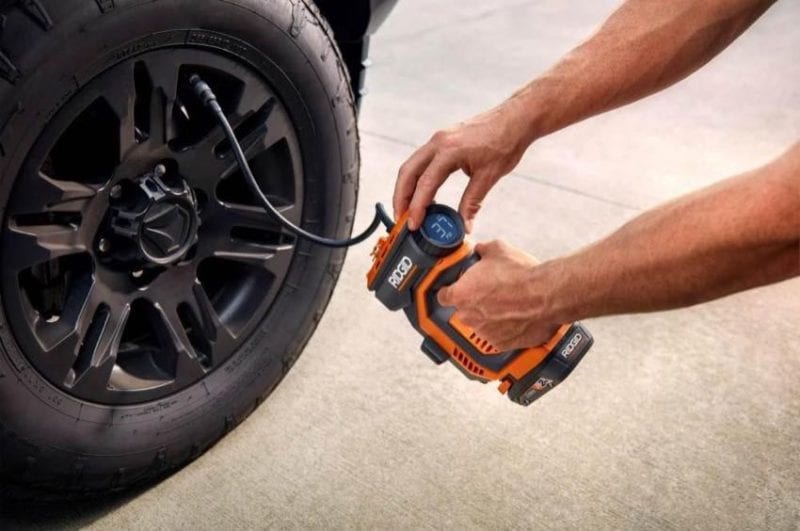
We’re tool guys. When we hashed out the best inflator, most of us wanted a cordless option rather than a 12V that connects to the car.
After much debate, we chose the $59 Ridgid 18V digital inflator. Our justification? It’s faster at filling than most others we’ve tested. Adding to its value, it eliminates the cordless vs 12V debate. How? By including a 12V adapter, giving you the best of both worlds.
- Also recommended: Milwaukee M18 cordless inflator
Best Quiet Air Compressor
Makita Quiet Series 3 Gallon Air Compressor MAC320Q
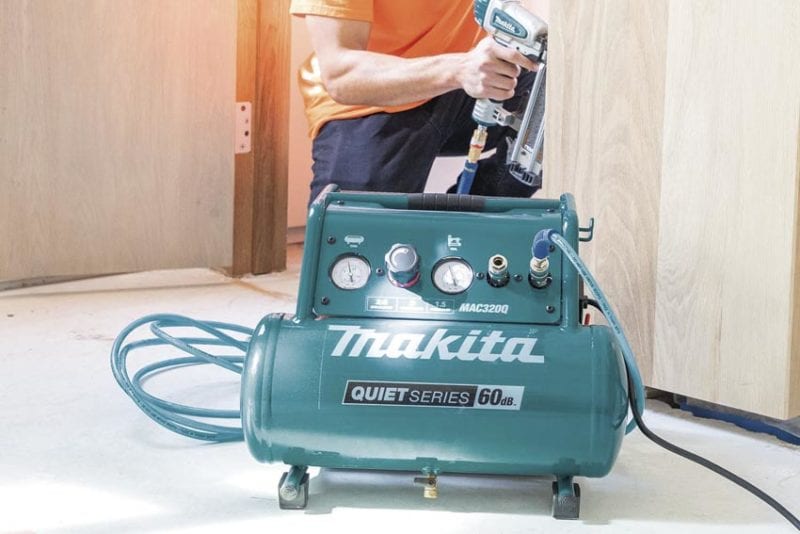
At 60 decibels, the Makita Quiet Series 3-gallon air compressor is quiet enough to hold a conversation next to it. However, it’s not just the noise level that made it our choice as the best quiet compressor.
The MAC320Q offers better air delivery than most. With up to 2.6 CFM at 90 PSI, it maxes out 135 PSI in its 3-gallon tank. Keeping the noise down by running at 1750 RPM, it still takes just 65 seconds to charge and only requires 8.5 amps to run. You can grab this compressor for under $200.
Best Cordless Air Compressor
Milwaukee M18 Fuel 2-Gallon Quiet Compressor 2840
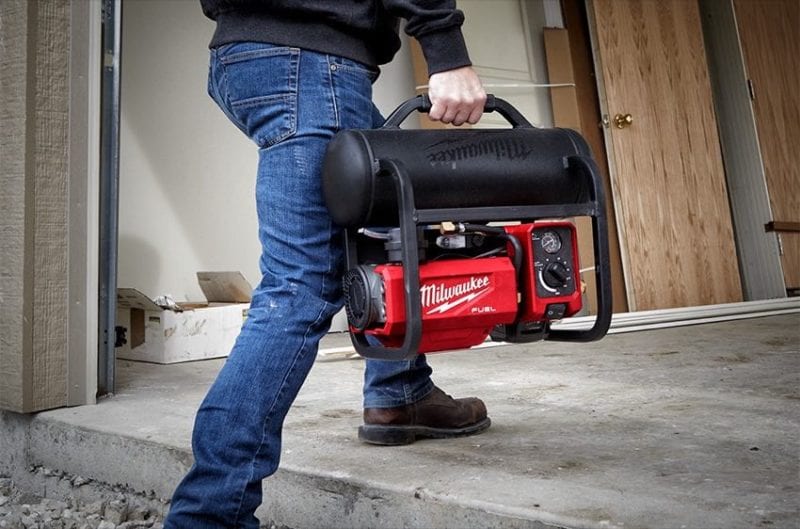

Both the DeWalt FlexVolt air compressor and the Milwaukee cordless compressor both make solid cordless compressors that have similar specs. Milwaukee earns the nod from our review team with a system that runs on its popular 18V batteries. It’s also 11 decibels (dBA) quieter. That’s a significant noise difference considering our Pros see cordless compressors as a primarily indoor air source. It’s $379 as a bare tool and $598 with a 12.0Ah battery. This tool also earned a 2020 Pro Tool Innovation Award.
DeWalt makes its case with a little higher tank capacity (2 gallons compared to 2 1/2) and a $329 price tag that includes a battery and charger. DeWalt’s lower price is certainly enough to grab some attention.
- Also Consider: DeWalt 60V Max 2.5 Gallon Air Compressor Kit
Best Wheelbarrow Air Compressor
Metabo HPT Tank XL Wheelbarrow Compressor
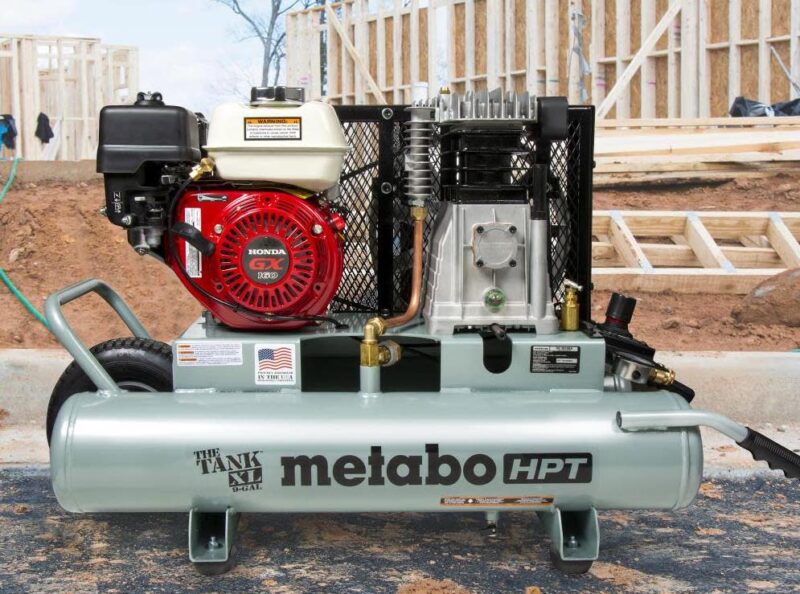
Metabo HPT shows up once again on our list—but they really seem to be on a roll. They simply nailed the design of their 9-gallon Tank XL wheelbarrow air compressor. Powered by a Honda GX160 engine, it oozes long-term reliability. With a pair of 4.5-gallon tanks, it delivers 9.5 CFM at 90 PSI—dropping only slightly to 9.3 CFM at 100 PSI. We also really like the solid rubber maintenance-free tire for navigating nail-ridden jobsites. From start to finish, we think the Metabo HPT has the all-around best wheelbarrow air compressor available.
Best Shop Air Compressor
Ingersoll Rand 80-gal 5 HP 230V Single Phase Air Compressor
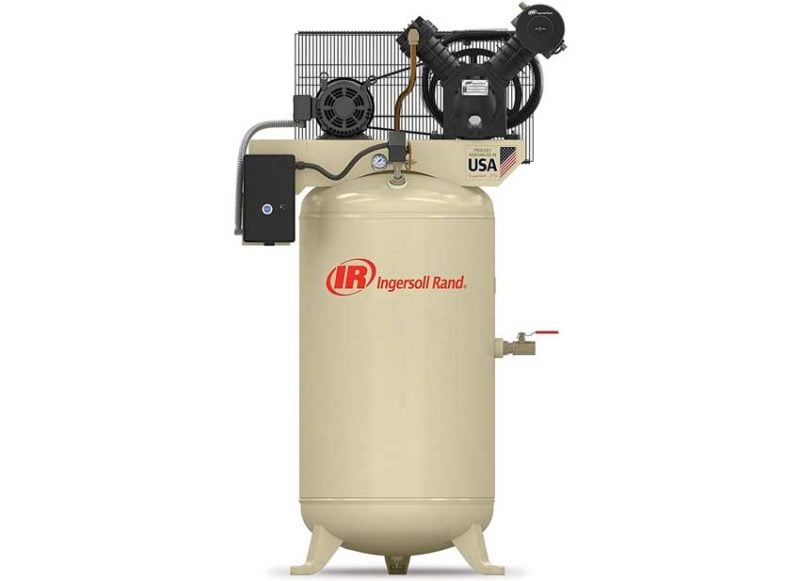
Things got heated when we started talking about the best shop compressor. One thing is clear: Ingersoll-Rand, Jet, and Rolair dominate the shop compressor space in the opinion of our review team. Either of those brands represents a solid choice.
We decided to base our choice on the best single-stage 80-gallon air compressor each brand offers. We realize there are a lot more choices than just this design we narrowed it down to, but we had to make a decision and this seemed like the best all-around.
This Ingersoll-Rand offers 100% duty cycle operation with 17.8 CFM (and models that go up to 24 CFM or more). At over $3100, expect to pay for the quality you get with this system.
If you’re working on a tighter budget, consider the comparable 5HP 230V Campbell Hausfeld HS5180 80-gallon two-stage air compressor. It delivers 14 CFM and nearly halves the price.
Editor’s Note: Be sure to also check out our recommendation for the best portable air compressor for your home garage
Best Air Compressor for the Money
Metabo HPT Air Compressors
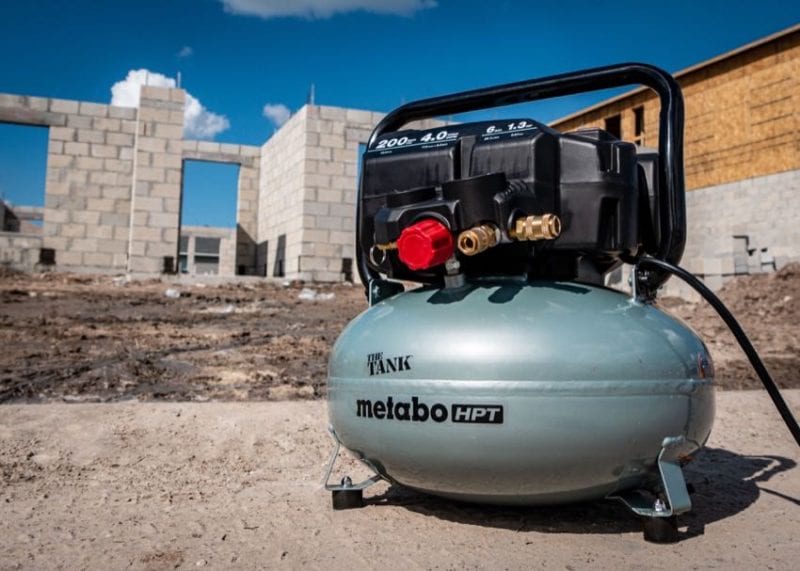
When it comes to name-brand, professional-grade models, we turn to Metabo HPT to get the best air compressor for the money. While they’re not the cheapest, they consistently pack better performance than their competition for the dollar. With a long heritage of building quality nailers, it’s no wonder they have compressors dialed in as well.
Kobalt Air Compressors
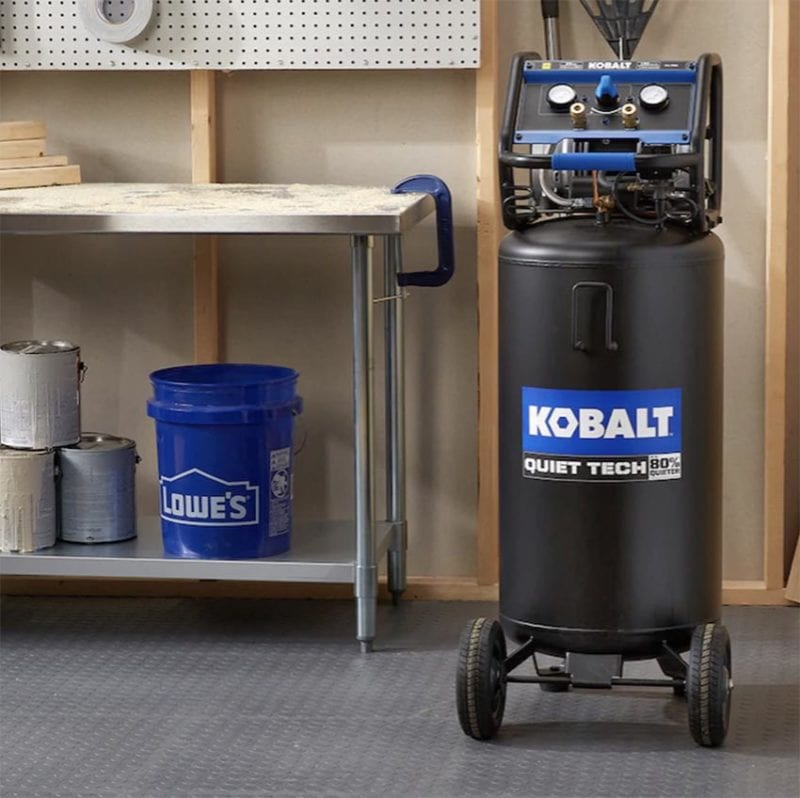
There are several great brands to choose from when you’re looking for an inexpensive air compressor. Husky and Ridgid both offer a lot of bang for your buck. Topping out both brands is Kobalt. Found at Lowe’s, they have a wide selection. What sets Kobalt apart are a couple of larger-capacity quiet compressors that Husky doesn’t offer while still reaching up to 80-gallon models.
Best Air Compressor Brand
Rolair Air Compressors
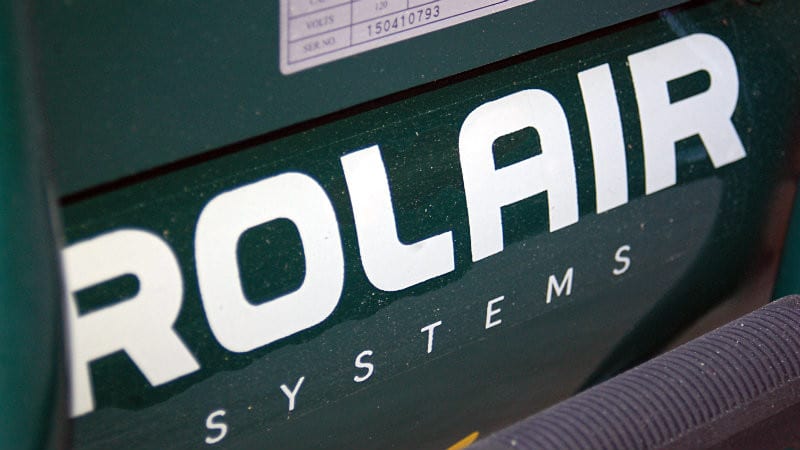
When cost is no object and you’re targeting the highest quality across an entire line, more of our Pros turn to Rolair than any other brand. With a history dating back to 1959, the Wisconsin-based manufacturer says it quite simply, “Our goal was simple: Produce the finest compressors known to mankind.”
In our opinion, they still do.
Air Compressor Buying Guide
Power Source
The most common air compressors run on either gas or electric power. Electric models can be either 120V or 240V, depending on the level of performance they have.
Smaller electric compressors are highly portable. They can run on a generator if you don’t have a direct AC power supply nearby. On the other hand, larger units tend to be installed in place and piped to the most convenient locations where you install connectors for your hoses.
Gas units are usually reserved for jobs that require high air delivery when mobility is a priority.
Battery-powered air compressors are becoming more popular with several major power tool brands making them. These are typically lower-power options that are best for finish nailers and other low-supply applications.
CFM and PSI
When you’re shopping for an air compressor, CFM and PSI are the key specs. They tell you the most about the performance you can expect.
CFM (often measured at 90 PSI) lets you know know the volume of air the unit can sustain. You can actually get higher CFM out of the tanks, but the pump won’t be able to replace it as fast as you’re using it. That means you have to take some “breaks”. Some tools, such as finish nailers, require very little CFM to keep up with the pace of the work. Other tools, like air sanders, need much higher CFM values to keep running.
PSI (pounds per square inch) is a measurement of the maximum pressure the pump can put in the tank. The higher the pressure, the greater the amount of air the tank can hold. 125 PSI is a good starting point and 200 PSI gets you into the high end of the spectrum for the most common units.
The reality is that every tool has its own CFM and PSI requirements. Check the package or the manual for the tool you’re considering and make sure the air compressor you’re buying can handle both. To make sure you get the most from your compressor, we recommend going with a model that gives you 50% higher CFM than your highest tool’s needs.
Tank Capacity
Tank capacity is a measure of the amount of air volume your compressor can hold. Each tank has a pressure rating and pairs with a pump. The higher the pressure the pump delivers, the greater the total amount of air the tanks hold. After that, the number of gallons determines the rest of the equation for understanding how long you can work.
Pro Tip: Drain your air compressor after every use. The air that comes in carried moisture with it and can start to rust the tank from the inside, especially around coastal areas.
Even if you find your compressor’s tank capacity is a little low, you can add an additional reserve tank to increase it.
Pro Tip: Every tank has an expiration date. Replace it once you reach that date to ensure the tank doesn’t fail.
Couplers
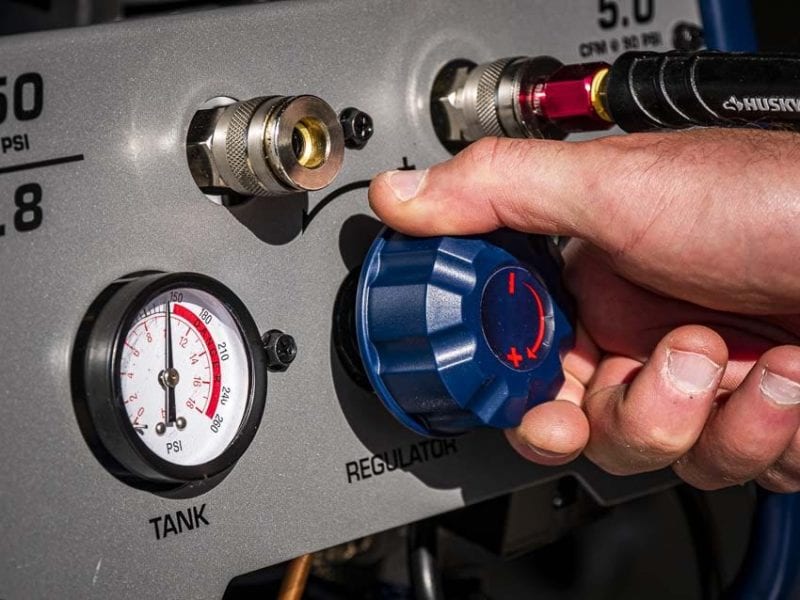
Most portable air compressors have one or two couplings on board. It’s also possible to add a two or three-way splitter. Just be aware that you’re sharing the air and your system needs to work harder to keep up.
Noise Level
Air compressors can be noisy! Add in a small gas engine and they get loud enough that you’ll want hearing protection.
One way to reduce noise is with the drive style. Belt drive compressors run quieter than direct drive by nature.
If you frequently work indoors, in occupied spaces, or around noise-sensitive campuses, look for a quiet compressor. These can drop down below 60 decibels (though most are more) and operate at a level you can actually hold a conversation next to.
Most quiet models are on the lower air delivery side. That means you’re unlikely to find one that’s good for sanding or roofing.
Duty Cycle
Duty cycle is a rating that tells you the percentage of time your compressor can run. For example, a 50% duty capacity tells you it needs 30 minutes of downtime for every 30 minutes of running.
If you’re looking for the best model in a high-use environment, check the duty cycle rating. Look for a compressor with a 100% duty cycle for high-demand work. For work that doesn’t keep a compressor working to keep up the entire time (most common), a 50% duty cycle is just fine.
Pump Type
Without going into a ton of detail about air compressor pumps, there are two basic types: oiled and oil-free. Oil-free models are much more convenient since you don’t have to worry about oil levels and require less maintenance.
Don’t be afraid of splash lubricated compressors, though. They don’t require a ton of refilling even though you should keep an eye on the levels frequently. In the end, your best bet is the compressor that meets your tools’ requirements whether it needs oil or not.
Types of Air Compressors
We mention several different types of air compressors above. If you’re shopping for your first one, here’s a breakdown of what we mean:
Pancake Air Compressor
Pancake air compressors use a round, flatter tank style with the motor and pump on top. They’re highly portable and stable with a relatively small footprint. These are a favorite among trim carpenters.
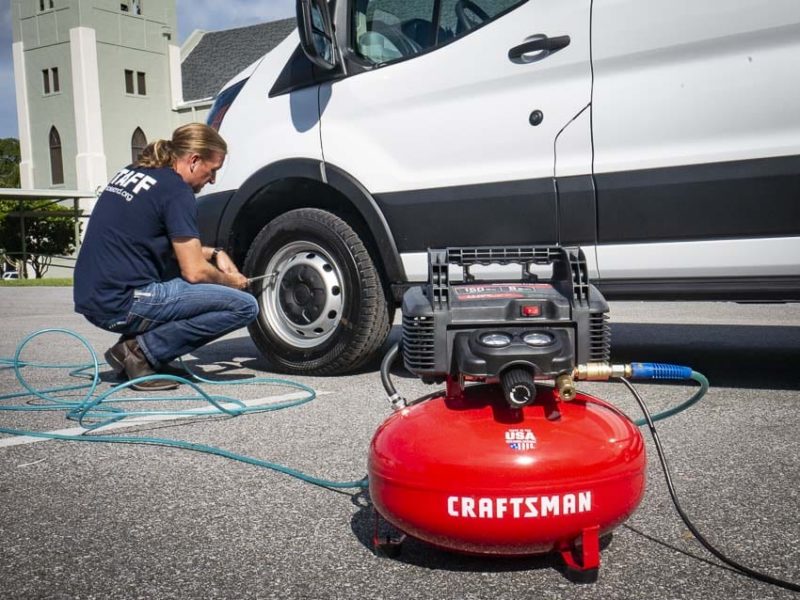
Hot Dog Air Compressor
A “hot dog” air compressor uses a single, longer cylinder-shaped tank with the motor and pump up top. Smaller capacity models are similar in footprint to pancake designs while larger capacities tend to take up more room. Some models may have a wheel system built into the frame.
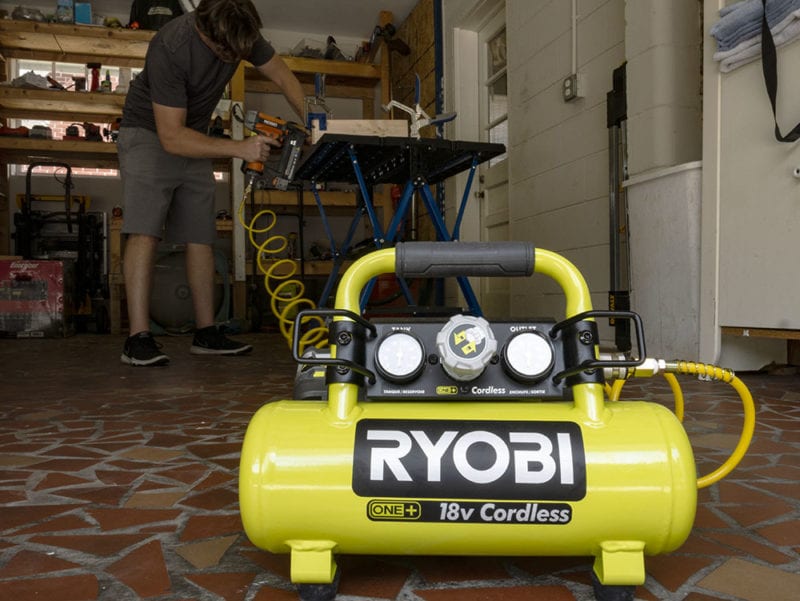
Twin Stack Air Compressor
Essentially, a twin stack air compressor features a double hot dog style. The two tanks can be on the base or stacked on top of one another with the motor and pump shifting from the top to the front side. The advantage is primarily additional capacity. Some models will have a wheel and handle system built into the frame.
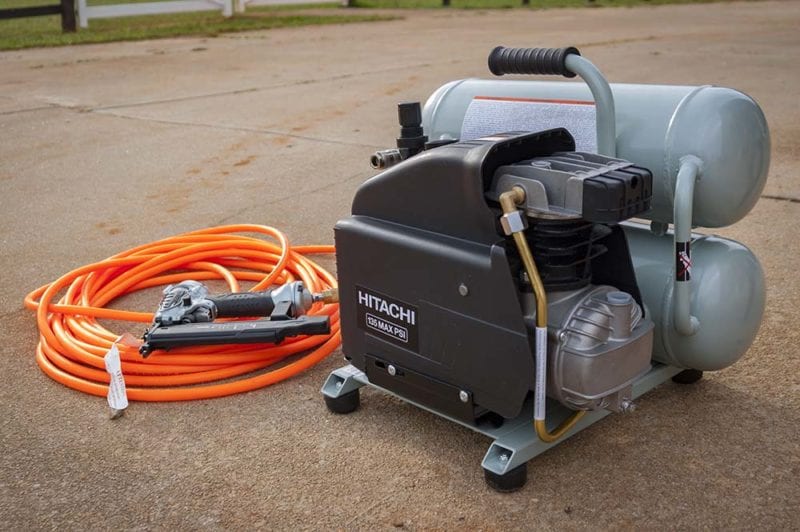
Wheelbarrow Air Compressor
Take a twin stack air compressor and feed it some and you get a wheelbarrow compressor. These usually feature two high-capacity tanks on the base with a gas engine for its power plant (there are also electric models). A single wheel between the tanks and handles on the opposite side make it portable despite its much heavier design.
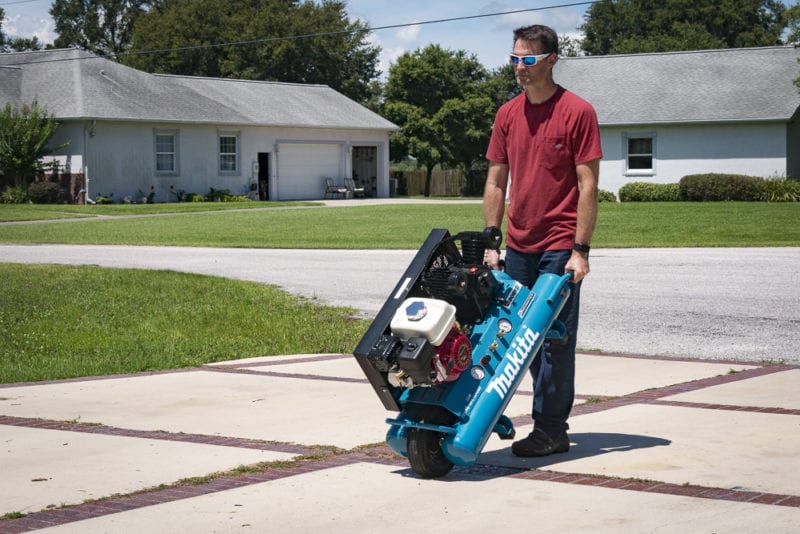
Vertical Air Compressor
Vertical air compressors use a single high-capacity tank with the motor and pump mounted on top. Smaller models usually have a handle and wheels that you can move around similar to a hand truck. Larger models are designed to be installed and stay in place.
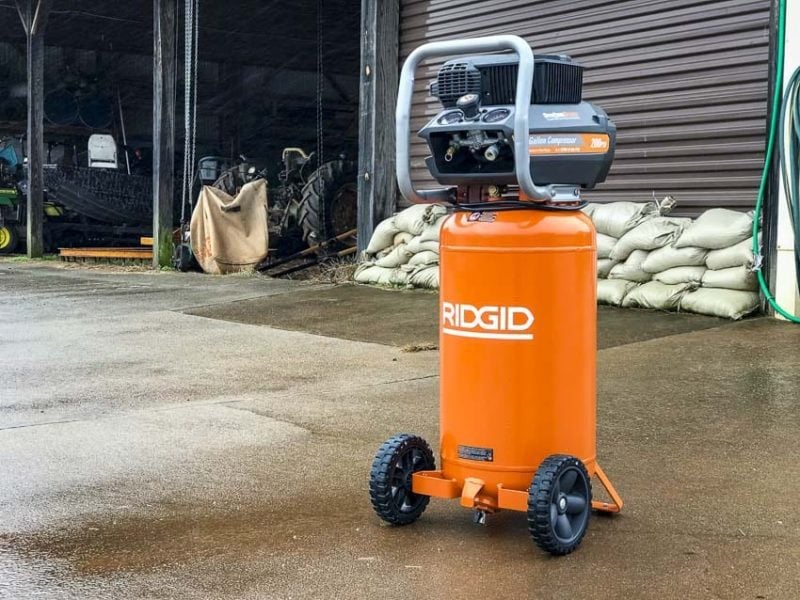
Why You Can Trust Pro Tool Reviews
Ever check out a “review” site and you can’t tell if they actually tested the tools or if they’re just “recommending” the Amazon top sellers?
That’s not us. We only recommend what we’d actually use, even if we don’t earn a commission from it. It’s all about giving you a legitimate recommendation and our honest opinion of each product.
We’ve been in business since 2008 covering tools, writing reviews, and reporting on industry news in the construction, automotive, and lawn care industries. Our Pro reviewers work in the trades and have the skills and experience to know whether tools can perform well in the field.
Each year, we bring in and review more than 250 individual products. Our team will put our hands on hundreds of additional tools at media events and trade shows throughout the year.
We consult with innovators in the technology and design of tools to gain a broader grasp of where these products fit and how they work.
We work with more than two dozen professional contractors around the United States who review products for us on real job sites and consult with us on testing methods, categories, and weighting.
We’ll provide more than 500 pieces of new content this year absolutely free for our readers—including objective evaluations of individual tools and products.
The end result is information you can trust because of the editorial, scientific, and real-world professional experience we collectively utilize each and every time we pick up and test a tool.

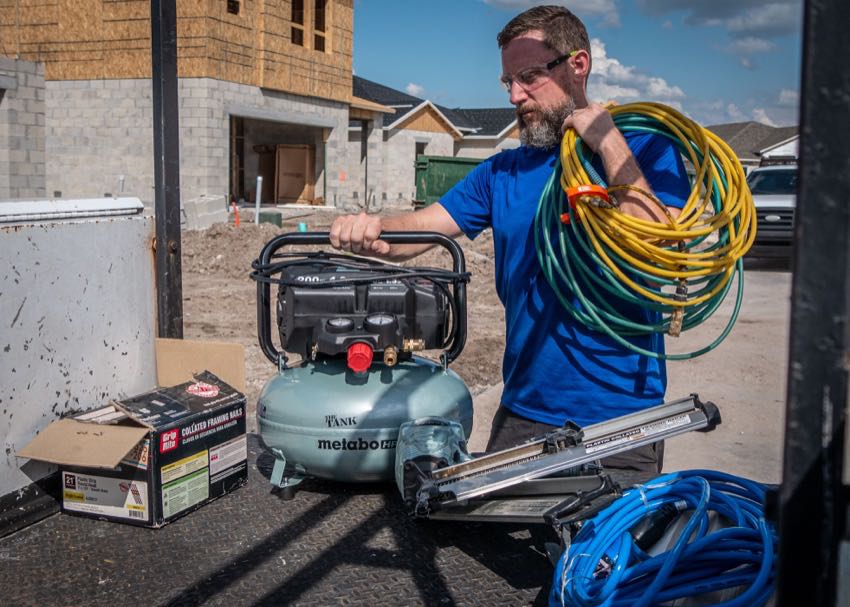
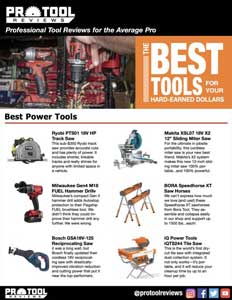


The Tank from Metabo is a well built air compressor but they are too loud. I have tried three of these and the average decibels is 98 at three feet away. There is a guy on YouTube that does a review and he has a decibel reading of 71, so, either that is a faulty decibel reader or he got a very good Metabo or he figured out a way to put a muffler on this thing to make it quieter. You have to wear ear protection around this compressor. The average time to get to 200 PSI for these… Read more »
Reading about small portable compressors one should condsider the 1750 rpm units vs 3450 rpm units of the same horsepower. Larger pump at half the rpm’s will last a lot longer than the high rpm units as well produces less heat, the pumps enemy. On larger 60-80 gal. with motor on top like 5 hp and two stage is what I wanted and found used in great shape. Here no mention about industrial grade compressors which on the top of the list is the Saylor Beall compressors especially the pressure lubed pump versions over any other major brands of spash… Read more »
I’m gonna give it another generation of cordless before I drop my corded small air compressor.
I’d like to see an OEM create a 2.0+ CFM cordless.